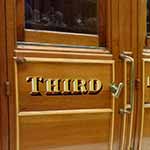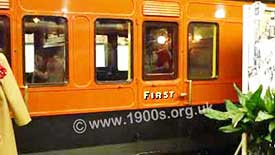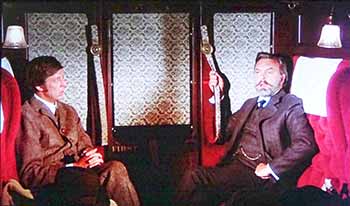First, second and third class train travel in Britain

This page briefly summarises the different classes of train travel in Britain from just before the Second World War, and goes on to present and comment on pictures of First, Second and Third class train carraiges.
____
By the webmaster based on her early recollections with additional research and firsthand contributions
The historical background for the pictures
Before the Second World War there were three classes of rail travel in Britain: first class, second class and third class. The differences between them were essentially in comfort and amenities.
During WW2, though, which is the earliest I remember, the class system and the restaurant facilities were abolished. People just travelled on whatever train happened to be running on the route they wanted to use. I do, though, remember seeing a rather scruffy carriage labelled 3rd class in a railway siding and I could just see that it had wooden seats with no padding.
In 1948, i.e. just after the war, the railways were nationalised under the newly formed British Railways, and first class, second class and third class travel were briefly reintroduced. Then in 1956 third class and second class were merged.
In 1965 British Railways became British Rail.
The railways are now run by a number of separate regional operators under the umbrella of National Rail.
If you are looking for what train travel was like in the past, that is on another page.
First class trains
I never knew anyone who travelled first class, as this would have been regarded as dreadfully wasteful by ordinary people, but I saw that it existed as it still does today.

First class coach / carriage, photographed in York Railway Museum. Note that it is marked 'First' on the door.

Inside a first class train department before WW1. Note the personal lamps, the chairbacks to save the backs of the seats from greasy hair, the strap to hold if the journey was bumpy, the lush upholstery and the privacy window glass. Screen shot from an old film.
It was and still is not difficult to peer through the windows of first class carriages from the platform. What has not changed is that what the passengers there are paying for is space, 'peace and quiet' and 'People Like Us'. The seats were and still are larger with more padding and with more leg room, but not, to my mind, worth the extra cost.
Pullman dining cars
I just remember seeing parked carriages known as Pullman cars which served food. I saw them linked next to first class compartments and carriages. What more I know of them comes only from what I was told by older people. Apparently they were very elegant, with ornamental table lamps and linen table cloths on the tables. Waiters in white coats took orders for meals which were cooked - not reheated - on the train.

Inside a Pullman car, detail of a photograph in York Railway Museum
Second class

Second class coach / carriage, photographed in York Railway Museum
Third class

Third class coach / carriage, photographed in York Railway Museum. It had clearly been given a coat of varnish as those I remember looked really tatty.
There is a 1954 third class season ticket on the tickets page. As I know the family who contributed it, I am sure that the travel would, by then, be completely acceptable to anyone. Within two years, of course, the third class would be merged with standard class, so the trains were probably already being upgraded.
| sources | webmaster | contact |
Text and images are copyright
If you can add anything to this page or provide a photo, please contact me.



